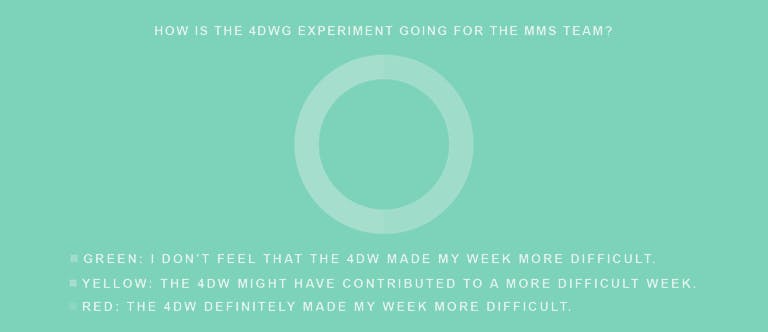Cut the Noise: "But What Will the Clients Say?"
by Lauren McGuire, President
Though it’s easy to assume so, we didn’t join the 4-day week to get more time off. We joined the 4-day week to be our most creative, and our most productive, for our clients. That’s the goal.
With their needs in mind, we knew that veering from the industry standard — the 5-day work week — couldn’t be done in a vacuum. We considered the 4-day-week for 3 years before finally pulling the trigger, with the help of the framework provided by 4 Day Global. And since we started it, we’ve kept the conversation open with clients and partners, calibrating on ways of working and always sourcing feedback.
When we talk about participating in the 4-day trial, there are two main reactions we receive: and they tend to be divided along the lines of creative partner agencies vs clients.
From some of our creative partners, we’ve gotten a dose of of incredulity and skepticism. A few of those responses:
• We could never do this. Our deadlines are too brutal.
• I had to work until 3 AM and every weekend when I started. Where’s the work ethic these days?
• Our clients will never go for it.
I understand all of this. To address these (very understandable) concerns, there are a few ways we’ve approached them:
🥊 Our Actions to manage creative, client-driven projects in 4 days
📊 The Data on stress and work today, and why we need to think differently
👂What We Heard from our clients when we told them
“Stress is bad for creativity. If we can give people back a day, does it make a difference in the value we bring to clients? We thought it was worth a shot.”
🥊 Our Actions
• Like with weekend work in the past, we do what we must in the face of a deadline. But Friday work happens less for any given employee. And as we always have treated weekend work, we try to keep it as a last resort.
• Some team members and many from our leadership team (myself included) use Friday to tie up loose ends. It’s faster, more enjoyable, and benefits from clearer thinking without the ping of internal Slacks and meetings. For me personally, what used to be weekend work now happens on Friday AM.
• We’re more disciplined in how we plan, both our projects and our days. We book meetings far in advance – the entire project calendar if we can. We maintain regular momentum to those meetings, including internal reviews. We have a small team to pivot quickly with creative curveballs, and always have a calendar to help keep reviews on schedule.
• We work harder to avoid unnecessary fire drills. Let’s be honest — it’s usually leadership pulling the alarm. Through this process, we’ve learned about the “Mere Urgency Effect.” When we are stressed, completing seemingly urgent (yet actually unimportant) tasks can provide relief. Scheduling and attending meetings can make us feel like we’ve accomplished something. But are we? We ask more questions, focus on mindfulness, and when someone falls into old habits, we call it out.
📊 The Numbers
We all know so much has changed since the early aughts to increase stress and anxiety (constant pings to your mobile device and no place to hide!) but the struggle with internalized capitalism is real for us Gen Xers. So, some grounding data to remember:
• 83% of US workers suffer from work-related stress. Everest College’s comprehensive survey shows that the overwhelming majority of US workers are stressed as a result of work.
• In 2019, 94% of American workers report experiencing stress at their workplace. According to Wrike’s United States stress statistics from 2019, only 6% of workers don’t report feeling stressed at work.
• 42 percent of women and 35 percent of men reported feeling burned out “often” or “almost always (McKinsey)
Stress is bad for creativity. Burnout is bad for creativity. Turnover is bad for a creative company. If we can give people back a day, does it make a difference in the value we bring to clients? We thought it was worth a shot.
👂 What We’ve Heard from Clients
We’ve worked hard to super-serve our clients over the years. The goal is to continue to provide the very best creative product and this is one way we think we can do it. So without tooting our horn, we were told we earned into this experiment — even new clients did not express concern when this was shared.
Something we also heard more than once, “I try to avoid Friday meetings anyway.” Some expressed a touch of jealousy and we had multiple clients say, “I need to tell my leadership about this.”
But the overwhelming theme? “You are great partners, and we trust you.”
Some of this surprised us and maybe it surprises you too. Halfway through our trial, we continue to learn how to optimize our teamwork and time to get more space for creativity to grow in a 4-day week. We are an open book for anyone who wants to hear more.
🧡 Where We’re at This Week
A 4-day week sounds dreamy but you have to learn to work differently and we’ve been warned — there is a curve. So every two weeks we are asking staff how the experiment is going for them, with a simple visual chart below.
We have the holiday — and resulting 3-day week — to thank for this yellow-heavy week. But halfway through the experiment, and no red responses? I’d call this a positive.

Cut the Noise is a column from Made Music Studio President Lauren McGuire, a place to share learnings from this experiment with 4 Day Week Global. She’ll share candid feedback from the MMS team, tools for productivity, meeting management, mindfulness, and more.
Read Lauren’s intro to Cut the Noise here.

